The Cell Blu-ray Movie
HomeThe Cell Blu-ray Movie 
Warner Bros. | 2000 | 109 min | Rated R | Jul 07, 2015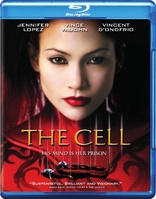
Movie rating
6.6 | / 10 |
Blu-ray rating
| Users | 4.3 | |
| Reviewer | 4.0 | |
| Overall | 4.2 |
Overview
The Cell (2000)
An FBI agent persuades a social worker, who is adept with a new experimental technology, to enter the mind of a comatose serial killer in order to learn where he has hidden his latest kidnap victim.
Starring: Jennifer Lopez, Colton James, Dylan Baker, Marianne Jean-Baptiste, Gerry BeckerDirector: Tarsem Singh
| Horror | Uncertain |
| Thriller | Uncertain |
| Psychological thriller | Uncertain |
| Sci-Fi | Uncertain |
| Crime | Uncertain |
| Drama | Uncertain |
Specifications
Video
Video codec: MPEG-4 AVC
Video resolution: 1080p
Aspect ratio: 2.40:1
Original aspect ratio: 2.39:1
Audio
English: DTS-HD Master Audio 5.1 (48kHz, 24-bit)
Spanish: Dolby Digital 5.1 (640 kbps)
German: Dolby Digital 5.1 (640 kbps)
Italian: Dolby Digital 5.1 (640 kbps)
Spanish: Dolby Digital 2.0
Japanese: Dolby Digital 5.1
Spanish 2.0=Latin; Japanese is hidden
Subtitles
English SDH, French, German SDH, Italian SDH, Japanese, Spanish, Dutch
Discs
50GB Blu-ray Disc
Single disc (1 BD)
Playback
Region free
Review
Rating summary
| Movie | 4.0 | |
| Video | 4.5 | |
| Audio | 4.5 | |
| Extras | 4.0 | |
| Overall | 4.0 |
The Cell Blu-ray Movie Review
Mind Meld
Reviewed by Michael Reuben July 6, 2015You have to wonder whether The Cell's screenwriter, Mark Protosevich, had any inkling of what would happen to his first produced script when it landed in the hands of Indian-American prodigy Tarsem Singh, whose commercials and music videos received acclaim throughout the 1990s. Protosevich, who would go on to write the story for the first Thor film and to adapt the remake of Oldboy, had written a classic serial killer genre piece in the Thomas Harris vein of Manhunter, Red Dragon and The Silence of the Lambs, but there was an added twist. In The Cell, the investigators had to go beyond profiling and actually enter the killer's brain to save the latest victim. Similar story elements have been used in other contexts, including the 1984 film Dreamscape and even on innovative TV shows like Star Trek: Deep Space Nine (Season 7: "Extreme Measures"). But when New Line gave Protosevich's script to Tarsem, the twist became the main attraction. Tarsem immediately grasped that deranged serial killers had worn out their novelty (which doesn't stop popular culture from churning them out faster than reality). What intrigued him was how the interior world of the mind freed much of The Cell's narrative from conventional logic. As he explains in the accompanying commentary, The Cell offered him an opportunity to do something you don't usually see in a police procedural: a grand operatic spectacle. Now, if the ad campaign for a film promised an opera, the box office would plummet. But a crime story filled with blood, terror, perverted sex and a beautiful female star—that's a movie people will pay to see. With a love-it-or-hate-it critical reception, The Cell was a box office success and also received an Oscar nomination for its memorably grotesque makeup.
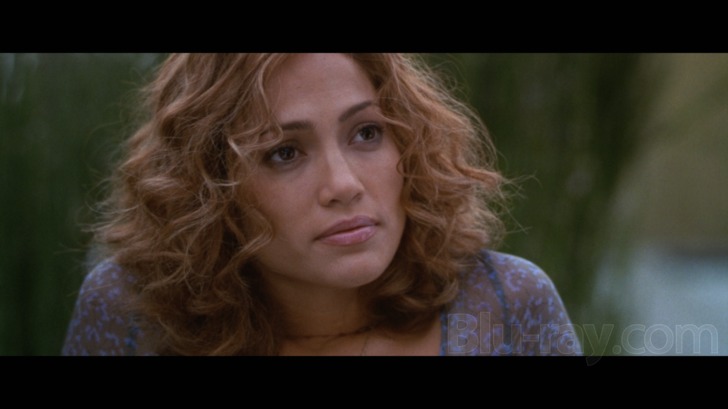
The cell of the title is an enclosed cubicle where serial killer Carl Stargher (Vincent D'Onofrio) imprisons his victims for a period of forty hours after drugging and kidnapping them. What happens to the victim during and after that time is gradually revealed during the film's first hour, and the location of the cell becomes the intense focus of FBI profiler Peter Novak (Vince Vaughn) and his partner, Gordon Ramsey (Jake Weber), as they race to find Stargher's current victim, Julia Hickson (Tara Subkoff), before it is too late. (Vaughn's casting as Novak was, at the time, a departure for an actor known for comedic roles, but as Vaughn is currently revealing on HBO's True Detective, he has a flair for such characters.) What gives Novak, Ramsey and their supervisor, Teddy Lee (James Gammon), some hope of finding Julia in time is that Stargher has left them forensic evidence on his most recent corpse, that of Anne Marie Vicksey (Catherine Sutherland). It's the first break in the case. The evidence will eventually lead the FBI team to Stargher's home, but their raid nets them a suspect in a coma, from which their top neurologist (Pruitt Taylor Vince) says he will never awaken. Enter the experimental procedure developed by Drs. Henry West (Dylan Baker) and Miram Kent (Marianne Jean-Baptiste), whose combination of drugs and technology allows a therapist to enter the mind of a patient. The research is funded by the billionaire parents of Edward Baines (Colton James), a boy so psychologically damaged—whether by illness or trauma is unclear—that he's been rendered catatonic. The therapist who has proven most adept at working with this new technique is Catherine Deane (Jennifer Lopez), a former social worker whose ability to adapt to the surreal terrain inside Edward's mind has astonished the scientific team. Now the FBI wants her to enter Carl Stargher's mind and learn the location of the cell where Julia Hickson is running out of time. Tarsem's elaborate staging of Stargher's rituals with his victims' bodies is disturbing enough—the director out-Harrises Thomas Harris—but it's in the dream landscapes of Edward's and Stargher's minds that he creates a unique experience, moving beyond mere grotesquerie into a kind of grand theater of the bizarre. The many artistic influences and references have repeatedly been catalogued, beginning with the obvious nods to Alien creator H.R. Giger and vivisectionist artist Damien Hirst, but the important point is how Tarsem and his creative team are able to keep these extreme images tied to the essential elements of their underlying story. Different aspects of Carl Stargher's personality manifest themselves throughout Catherine's journey through his mind, including a childhood version played by Jake Thomas, but both the writing and the editing (and Lopez's performance as Catherine) help maintain the connection among these various manifestations and the increasingly extreme visuals that accompany them. Meanwhile, Novak's activities serve as a reminder of the stakes in the real world. As Tarsem emphasizes in his commentary, The Cell doesn't really show you a "dream" world. Dream logic is very different from what Catherine experiences in her travels, and Tarsem cites David Lynch's Lost Highway and David Cronenberg's eXistenZ (which he saw eight times in the theater) as examples of more authentic "dream" films. No, as weird as it may be, The Cell remains an elaborate entertainment, staged strictly for your enjoyment (assuming this sort of thing gives you pleasure). It's the kind of subversive fare that might have been offered by the Théâtre des Vampires, in Interview with the Vampire, if they'd had 21st Century technology. At the end, you're glad you can walk away freely into the light and leave it behind, though you may find some part of the experience lingering in memory. (Note: I do not have the DVD for comparison, but I am advised that it contained the R-rated theatrical cut, which ran 107 minutes. The Blu-ray is also labeled R, but it measures 109 minutes, which is supposed to be the length of the "director's cut". If I receive further information, I will update the review.)
The Cell Blu-ray Movie, Video Quality 
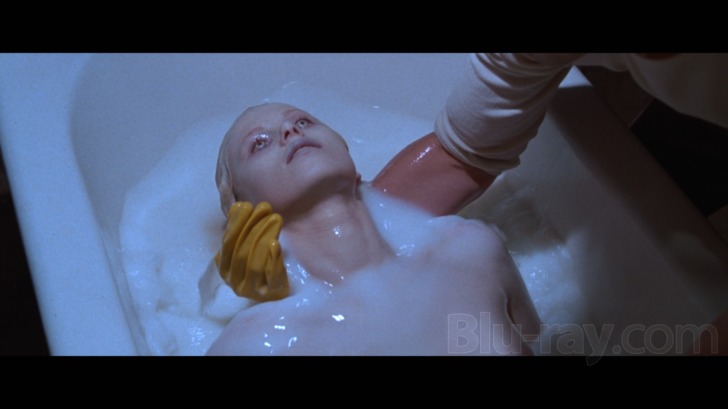
The Cell was photographed by Paul Laufer, who, like director Tarsem, began in music videos and TV commercials and has continued to work in those fields ever since. Laufer is one of the principal participants on the Blu-ray's "production team" commentary track, where he discusses The Cell's photography in great detail, including the challenges of obtaining the desired colors via photochemical means in the era just before digital intermediates. Although some parts of The Cell were "digitized" (as Laufer puts it) to achieve various effects, the film was still completed by traditional means, so that a transfer for Blu-ray required scanning of a film element. The Cell was previously released on Blu-ray in 2009 by Canada's Alliance Atlantis; Blu-ray.com's review can be found here. Reliable sources at Warner have advised me that no 1080p master for the film existed at the time, and that the likely basis for Alliance's Blu-ray was a 1080i broadcast master that was upconverted. For this 1080p, AVC-encoded Blu-ray release from Warner Home Video, a new 1080p master has been prepared by MPI, Warner's on-site facility. The results are exceptional. Tarsem and the production team used real, "in camera" elements wherever possible, so that the imagery would have weight and density and the actors would interact with real objects. The new Blu-ray captures this sense of reality with impressive depth and detail, enhanced by the clarity of the image and the vividness of the extreme color palette, whether it is the beautifully saturated reds of blood and various garments or the regal purples and golds favored by Carl Stargher's dream alter ego. The ghostly whites and blues associated with Stargher's victims are appropriately disconcerting, as are the various ashen qualities in his strange interior landscapes. In young Edward's mind, the reddish yellow of the vast sand dunes (filmed in Namibia) are striking in their hot intensity. Black levels and contrast are very good, and the film's grain pattern has been finely rendered. Warner has mastered The Cell at an average bitrate of 24.92, which could be better but is certainly very good, especially with careful allocation of bandwidth to the scenes that need it most. A quick comparison to the screenshots from our previous review will immediately reveal that the colors on this new version differ significantly. Warner's version is warmer overall, and has noticeably deeper reds and more lifelike fleshtones. As in all such situations, there is no reason to believe that the earlier version was accurate; indeed, it is far more likely that MPI would have had access to an answer print for reference than anyone associated with Alliance Atlantis. In any case, the difference is noted for the record.
The Cell Blu-ray Movie, Audio Quality 

Among the highlights of The Cell's original 5.1 track, encoded on Blu-ray in lossless DTS-HD MA, is Howard Shore's almost atonal score, which blends traditional orchestration with the "trance" music of the Master Musicians of Joujouka. The latter, with its distinctive blend of reed, pipe and percussion instruments provides an ideal accompaniment to the beautiful but alien landscapes of Edward's mind and also the sinister and vaguely oriental fantasies in which Stargher's mind indulges. Water (dripping, running, rushing, etc.) is a recurrent theme in The Cell's soundscape, for reasons that will quickly become obvious as the viewer grows acquainted with the world of Carl Stargher. Cars, helicopters, battering rams and other classic sounds of a police procedural also occur; at moments, Shore's score can't help but recall his earlier work for Se7en and The Silence of the Lambs. Dialogue is generally clear, except for certain utterances of Stargher's imperial alter ego, where the import is less what is said than the intensity with which he says it. Whenever speech occurs inside a mental landscape, voices boom, echo, fade and re-emerge, without regard to the laws of physics. The soundtrack's broad dynamic range and deep bass extension add to the sense that we have entered an alien landscape, even if it's all an illusion.
The Cell Blu-ray Movie, Special Features and Extras 
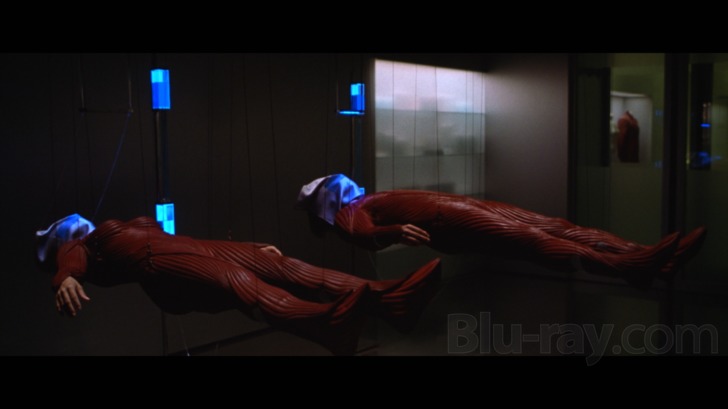
The extras have been ported over from New Line Video's 2004 "Platinum Series" DVD, with the exception of the "Interactive Brain Map and Empathy Test" and the DVD-ROM features (which included the screenplay).
- Commentaries
- With Director Tarsem Singh: Tarsem can be difficult to follow, because he speaks quickly and thinks even faster, so that he often seems to be changing direction mid-sentence. He imparts a wealth of information on multiple subjects simultaneously, including his inspirations, the compromises necessitated by time and budgetary constraints, his displeasure with actress Tara Subkoff for misleading him about her abilities as a swimmer, and his surprise at the sickened reactions elicited by some scenes after they were cut together.
- With Production Team: The participants are DP Paul Laufer, production designer Tom Loden, makeup supervisor Michèle Burke, costume designer April Napier, visual effects supervisor Kevin Tod Haug and composer Howard Shore. The comments were recorded separately, then edited together, and they are introduced by an unidentified narrator. There are many practical details about technical challenges in realizing various aspects of the production, along with reflections on the working atmosphere established by Tarsem.
- Style as Substance: Reflections on Tarsem (480i; 1.78:1, enhanced; 11:51): Tarsem and the production team of The Cell discuss his distinctive approach to visual storytelling.
- Deleted Scenes (w/Optional Commentary) (480i; 2.35:1, enhanced): No "play all" option is available. The scene entitled "Stargher's Room" was the film's original ending, which Tarsem now agrees would have been the wrong choice. The final deleted scene, "Extended Carl with Victim", was perhaps the film's most controversial and is the area where the U.S. theatrical and director's cuts differ.
- Trapped in the Cell (1:04)
- Despair in the Cell (0:43)
- Extended Raid (3:30)
- Early Exit (1:55)
- Novak and Ramsey (1:32)
- Stargher's Room (3:26)
- Extended Confrontation with Carl (4:18)
- Extended Carl with Victim (3:36)
- Special Effects with Multi-Angle Vignettes: This is the Blu-ray implementation of a DVD extra that utilized the multi-angle feature to allow switching among different perspectives. The Blu-ray version simply repeats the same narration by visual effects supervisor Kevin Tod Haug (and, in one instance, Richard "dr." Baily) while different angles play. One interesting error occurs in the first entry, "The Hoist", where storyboards are included for an obviously unrelated sequence that occurs much later in the film involving Agent Novak's rescue efforts.
- The Hoist (9:43)
- First Entry (17:00)
- Second Entry (18:47)
- Novak's Entry (11:25) (doc)
- Catherine's World (9:56)
- Edward's World (3:54)
- Trailers
- Theatrical Trailer (480i; 1.33:1; 1:23): "To stop him, you'll have to use your head. Or better yet, use his."
- International Trailer (480i; 1.33:1; 1:20): Same concept, more explicit visuals.
The Cell Blu-ray Movie, Overall Score and Recommendation 
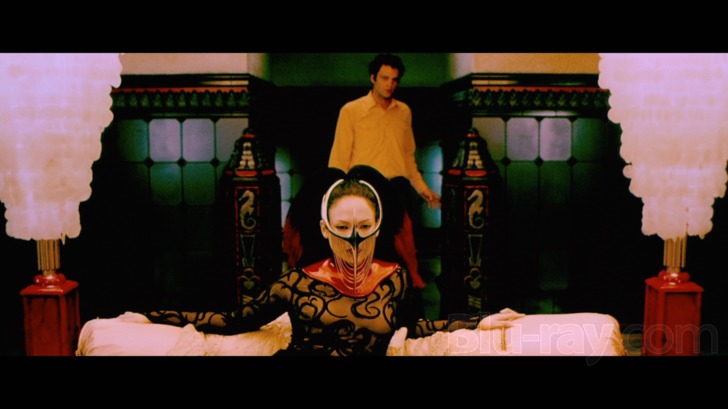
In a pivotal conversation midway through The Cell, Lopez's Catherine and Vaughn's Novak debate whether it is possible to feel sympathy for Carl Stargher, given the childhood abuse that made the adult a merciless killer. The debate takes physical shape in the imaginary landscape through which Catherine chases Stargher, because he can appear there simultaneously as a victimized child and as the merciless, god-like figure invented by his adult self to compensate. The film's narrative continuously cuts through this duality with the pleas and cries of Stargher's victims, which are heard throughout the film, both live and on tape. Novak listens to these above all else. Tarsem's oft-expressed surprise at the degree to which his visuals disturbed viewers may suggest a lack of appreciation, in his debut feature, for the power of sound to supply emotional depth to images, or even to redefine them completely. The Cell dazzles and disturbs, and, however one views the story's outcome, it's a visceral experience that has now been given a Blu-ray treatment it deserves. Highly recommended.
Similar titles
Similar titles you might also like

Maniac
2-Disc Special Edition
1980

Longlegs 4K
2024

Saw II 4K
2005

The Silence of the Lambs
1991

Frailty
2001

The Woman
2011

Raising Cain
Collector's Edition
1992

10 to Midnight
Collector's Edition
1983

13 Sins
2014

Hannibal: Season Two
2014

Funny Games
2007

Possessor 4K
Uncut
2019

What the Peeper Saw
1972

Tell-Tale
2009

Saw III 4K
2006

Saw IV 4K
2007

The Stendhal Syndrome
Limited Edition | La sindrome di Stendhal
1996

I Spit on Your Grave 2
2013

After.Life
2009

Wolf Creek
2016

